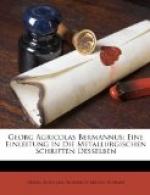|
This section contains 221 words (approx. 1 page at 300 words per page) |
World of Chemistry on Georgius Agricola
Georgius Agricola, born Georg Bauer on March 24, 1494, in Glauchau, Saxony, was the son of a draper. He studied Greek and philosophy at the University of Leipzig and medicine and natural science in Bologna and Venice. In Venice, he edited Galen's works on medicine and became friends with the scholar Erasmus who encouraged him to write his own books.
In 1526 Agricola returned to Saxony as town physician in Joachimsthal, a mining center where he pursued his interest in minerals that could be used as drugs. He visited mines and smelting plants and acquired a substantial knowledge of all aspects of mining, including miners' diseases. Agricola moved to Chemnitz, a small mining town that had a copper smelter, to serve as town physician and later as mayor. He remained in Chemnitz the rest of his life.
Agricola's major work De re metallica, published a few months after his death, is an illustrated compendium of Saxon mining knowledge including the geology of ores, mine construction and operation, and smelting and refining processes. Herbert and Lou Hoover translated this work into English in 1912. Agricola's other writings described a system of mineral classification based on geometrical form (no chemical analysis of ores existed in Agricola's time) and his theories of the creation of ore deposits. These works earned him the designation "father of mineralogy."
|
This section contains 221 words (approx. 1 page at 300 words per page) |


